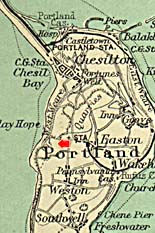|
⇒ Welcome ⇒ e-mail contact | |
| |
| |
| |
|
⇒ Cover ⇒ Preface ⇒ Introduction ⇒ The visit ⇒ Weymouth map c.1930 ⇒ Portland map c.1930 ⇒ Works quoted ⇒ Postface |
|
A visit to the Weymouth Sands of John Cowper Powys
[ ⇒
return... ]
|

THE QUARRIESThe base, or lower stratum, of this remarkable "island", is Kimmeridge clay...Above this rises the great solid mass of Oolitic limestone which we call Portland stone. This stone is on view anywhere and everywhere in Portland, but is seen to best advantage on the western side, where the cliffs rise perpendicularly from the beach.... Immediately below the shallow soil the limestone commences. This first stratum is not used for building purposes, but is excavated, broken up, and hurled over the edge of the cliffs... When this waste stone has been cleared from the quarry, a stratum called by the quarry-men the "dirt-bed" is reached. This is a remarkable formation. It is practically earth in which are embedded the trunks of trees and vegetable matter now petrified...Below the dirt-bed commences the Oolitic limestone used for buildings. Here it will be noticed that the stone is in such regular layers, each about six or seven feet deep, as to appear almost as if so placed by human agency. The third or fourth layers are the most valued. (Weymouth guide, Ward, Lock & Co., Ltd, about 1930) The Quarries, with the exception of those specially reserved by the Crown, are worked by leaseholders on a royalty. By a grant made by Charles II, in whose reign the quarries were first worked on any important scale, ninepence per ton on all stone quaried on the common land was allocated to a special fund for the benefit of the inhabitants, and sixpence for every ton raised in the Royal quarries, but the latter contribution was withdrawn in 1878. Convict labour is employed in the Crown quarries, but a large number of the inhabitants are employed in the private ones, and the quarrymen hand down the employment from father to son, and form a kind of guild among themselves, the intrusion of strangers, or 'kimberlins' as they are termed, being warmly resented. (Dorset by Frank R. Heath, Methuen & Co, 1927) "That," said the quarry foreman, as he included the landscape in a sweep of his hand, "is where St Paul's came from." I looked down toward the sea from a high cliff on the eastern side of the Isle of Portland. I saw a valley gouged out of the hill-side: a dead, desolate wilderness; a cutting away of high stone cliffs as if some race of giants had scooped out the stone to its bed, leaving exposed the grey, jagged roots of the rock, now covered here and there with grass and wild flowers... As I walked along the dusty roads of the island, which dazzle the eyes like snow in sunlight, I thought not only of the buildings which Portland has already given to London but of the London to be which we will never walk, that slumbers still in darkness in the womb of this pregnant Isle. There is a new Bank of England there. They will be cutting it out of the hills soon. There are new streets there. I had the queer fancy that perhaps my footsteps might echo down to the London of to-morrow, stirring it from its prehistoric slumbers, giving it an uneasy nightmare of destiny. And this I thought: that never again will I look on London with quite the same eyes. Always at the back of my mind will be, as I walk the streets of London, knowledge of a white island lying out to sea like a great whale. When I see Portland stone in London I shall think of the sea breaking against high hills; I shall hear the scream of the gulls, the suck back of pebbles on the little stony beaches; the white dust lying over the road in the little mysterious Isle of London. (H.V. Morton, In Search of England) |
[ ⇒ return... ] |
